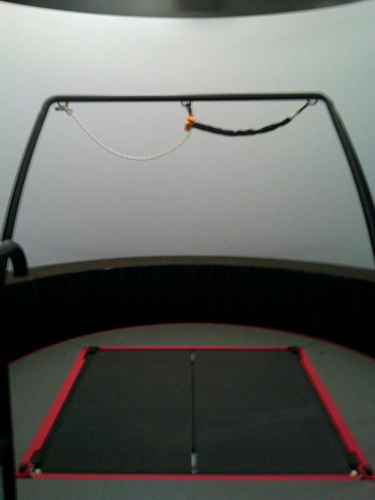Part 7: ‘Smarter’ facility being built to treat war wounded
For more than a hundred years, Walter Reed Army Medical Center has been the premier facility to treat war wounded who\'ve lost limbs. But when it shuts down, the...

Darci Marchese, wtop.com
WASHINGTON – For more than a hundred years, Walter Reed Army Medical Center has been the premier facility to treat war wounded who have lost limbs.
But when it shuts down, the new Walter Reed in Bethesda will assume that responsibility. Capt. David Bitonti, deputy commander for Transition and Integration at Bethesda, says starting over has its benefits.
“This was able to be designed from the ground up.”
Chuck Scoville, the chief of amputee patient care at Walter Reed, is the man behind the vision.
“My entire staff will be moving over to the Bethesda campus,” he says.
His entire staff includes about 45 employees. They are occupational therapists, physical therapists, psychiatrists, prosthetics, nurse care managers, social workers and traumatic brain injury specialists.
Scoville says it’s important for the patients to keep that consistency in care.
The facility will also be built better.
“We’re bringing together all the capabilities to one area, instead of having it spread around the facility. Now everything is on one floor.”
Just like at Walter Reed, amputees will have a large fitness center for physical therapy, an area for occupational therapy, an indoor swimming pool and a prosthetics lab double in size.
All of the rooms flow into each other for easy access.
In occupational therapy, David Oliveria, deputy chief of staff for Facilities at Bethesda, says patients with limb loss or nerve damage will re-learn “how to turn on a light switch, open a door, turn on a faucet.”
No ordinary task is easy anymore.
Right next to occupational therapy is the “Daily Living Room,” which is a mini living area with a dishwasher, stove, sink and a full bathroom.
“This is where someone who may have a disability now comes to learn to live in a non-ADA (American with Disabilities) world.”
At any given time, Scoville says there are typically 100 or so amputees actively engaged in rehab.
He says about 1,200 wounded warriors have suffered major limb loss since December of 2001, and he says remarkably more than “245 have gone back to active duty, and over 45 of those have gone back into Iraq or Afghanistan.”
It’s Scoville’s job to help amputees move on with their lives and go back to work. He uses some amazing pieces of technology, including a Computer Animated Rehabilitative Environment. The million dollar gadget was built in the Netherlands and there are only five of them in use in the U.S., all at military installations.
Scoville explains the CAREN system incorporates a number of different technologies to create a virtual environment for the patient. On a treadmill-like platform, they can learn how to run, walk, water ski, sail or even ride a motorcycle.
The patient gets strapped into a harness, they step on a platform that goes up and down three feet and there are wide screens surrounding them.
Scoville says it can help re-teach balance. For instance, if you’ve lost a leg on one side, Scoville says you tend not to put as much weight on that side which stresses the joints and back. The CAREN helps normalize that weight distribution.
It also can add math equations to measure cognitive skills as well as motor skills. It can even simulate a “city setting” for patients who’ve come back from war with a new fear of large crowds or cities.
“I can go from a very quiet, isolated street where you’re walking by yourself to New York City, middle of the rush hour,” Scoville says.
More than $70 million worth of equipment will be transferred from Walter Reed to the new Walter Reed Bethesda.
It includes a $1 million treadmill.
“There’s three of these in the world. We’ve had these specifically designed for us.”
The special treadmill has forced plates embedded into it, which helps teach amputees with new prosthetics to walk more comfortably on a grade. It also allows Scoville and his team to study how new prosthetic devices function on specific grades.
Other cool gadgets include a solo step, which is a running track with a harness over it. It helps teach amputees to re-learn how to walk, run, even skate board.
Scoville says the harness avoids a therapist from getting in the way.
“If they fall, the harness catches them so they don’t hit the ground. They kind of are suspended by the climbing harness, and they can get their feet back under them and continue to walk.”
Amputees will also have access to a tread wall and climbing wall which will help build strength.
Wounded warriors will also be able to check out the firearm training simulator. You use real weapons but not real bullets, to re-learn how to fire a weapon. The computerized device has over 200 scenarios.
“You could even learn how to fly fish with this thing,” Oliveria says.
Related Stories from Federal News Radio:
Related Stories:
- BRAC Impact: Why your world is about to change
- Why the shift: A history lesson
- Gridlock at Mark Center; Growth at Fort Belvoir
- No. of visits to new Walter Reed Bethesda to double
- BRAC: ‘Poster child’ for poor planning
- Impact of BRAC on military health care”
- An era ends at Walter Reed
Follow WTOP on Twitter.
(Copyright 2011 by WTOP. All Rights Reserved.)
Copyright © 2024 Federal News Network. All rights reserved. This website is not intended for users located within the European Economic Area.






